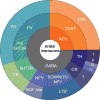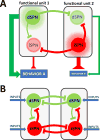Striatal Local Circuitry: A New Framework for Lateral Inhibition
- PMID: 29024654
- PMCID: PMC5649445
- DOI: 10.1016/j.neuron.2017.09.019
Striatal Local Circuitry: A New Framework for Lateral Inhibition
Abstract
This Perspective will examine the organization of intrastriatal circuitry, review recent findings in this area, and discuss how the pattern of connectivity between striatal neurons might give rise to the behaviorally observed synergism between the direct/indirect pathway neurons. The emphasis of this Perspective is on the underappreciated role of lateral inhibition between striatal projection cells in controlling neuronal firing and shaping the output of this circuit. We review some classic studies in combination with more recent anatomical and functional findings to lay out a framework for an updated model of the intrastriatal lateral inhibition, where we explore its contribution to the formation of functional units of processing and the integration and filtering of inputs to generate motor patterns and learned behaviors.
Published by Elsevier Inc.
Figures





References
Publication types
MeSH terms
Grants and funding
LinkOut - more resources
Full Text Sources
Other Literature Sources

